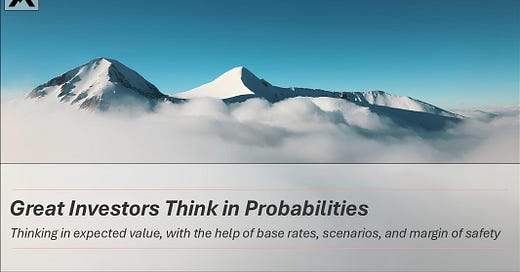Great Investors Think in Probabilities
Thinking in expected value, with the help of base rates, scenarios, and margin of safety
Investors like myself tend to rely on models with overly precise outcomes, and then cling to them. We assign a single fair value to a business, anchor to it, and treat price deviations from this value as mispricing.
But that number—that value we’ve calculated—should really represent expected value, not one definitive outcome. Expected value is something else entirely: it reflects a range of possible payoffs, each with its own probability.
I’m turning to the one and only Michael Mauboussin for help. Together with Dan Callahan, he explores why valuation is fundamentally probabilistic. A model with one set of assumptions can’t possibly capture the true distribution of potential outcomes.
Great investors think similarly. Here’s Warren Buffett:
“Take the probability of loss times the amount of possible loss from the probability of gain times the amount of possible gain. That is what we’re trying to do. It’s imperfect, but that’s what it [investing] is all about.”
In this post, I’ll explore the benefits of expected value, thinking probabilistically, and how this mindset can help you better size positions and ultimately improve your returns.
Expected Value
Most valuation models produce a single number, a fair value per share based on a specific forecast. That number becomes the anchor for investment decisions: if the price is lower, the stock is undervalued. If it’s higher, it’s not.
But that’s not how valuation actually works.
The real value of a business is the weighted average of all possible future outcomes. That’s expected value.
Of course, there’s a problem: we don’t know all the possible outcomes, nor do we know the exact probabilities. So expected value thinking will always involve some level of guesswork.
But it’s still a better framework than pretending one future is certain.
It forces you to think in distributions. A company with a wide range of outcomes, both to the upside and downside, might seem too unpredictable to touch. But if the worst-case scenarios are extremely unlikely, and the upside probability is high, the expected value could still be attractive.
It forces you to ask better questions:
What are the possible futures for this business?
How likely are they?
And how confident am I in those probabilities?
In the end, expected value is about asymmetry: structuring your portfolio so that when you’re right, you gain much more than you lose when you’re wrong.
Mauboussin suggests a few practices that help thinking in expected value terms. These include using base rates, expanding the range of scenarios, and applying a consistent margin of safety.
Base Rates
History doesn’t repeat itself, but it often rhymes. The same goes for business performance.
That’s why investors rely on historical data to forecast future growth. We tend to taper growth over time, and sound DCF models shift to the terminal value once ROIIC converges with the cost of capital. But how often are those assumptions actually grounded in data?
Personally, I compute a forecast horizon by doing qualitative analysis; wide-moat businesses deserve longer forecast periods and vice versa. But these forecast horizons are little more than off the cuff estimates, and it’s just one scenario.
To validate projections for growth, margins, and reinvestment, we should anchor them in historical distributions, not just for the company in question, but for a broader set of similar businesses.
What happened to other companies like this in similar situations?
That’s the question to ask. If you’re analyzing a mid-cap retailer, for example, how did similar retailers grow over the next 5-10 years? How often did margins expand meaningfully? What was the typical reinvestment rate?
These kinds of base rate comparisons are useful for forecasting, and they provide a good sanity check. If your assumptions deviate meaningfully from historical norms, you should be able to back that up.
Finding these base rate statistics, however, isn’t straightforward, which is why we have these planned on our roadmap for Summit’s Analytics. Eventually, you’ll be able to see how your assumptions compare to historical distributions across sectors and business models, all in one place.
Model More Scenarios
Most models include a bull case, a base case, and a bear case. It’s intuitive and simple, but often gives a false sense of completeness.
A bear scenario rarely results in the bear case coming true. Real-world outcomes don’t fall cleanly into “good,” “average,” or “bad.” Businesses follow nonlinear paths, while small changes in revenue growth or cost structures can lead to disproportionate changes in cash flow.
Expected value thinking works best when it’s built on a wider range of possible futures. One way to start is by expanding your scenario set. Mauboussin suggests using, for example, five scenarios instead of three, arguing the insights gained from more scenarios is worth the trade-off of additional complexity.
A more sophisticated way—and the subject of a follow-up post—is to use a Monte Carlo simulation, which can “lead to a deeper appreciation of potential probabilities and payoffs.” Instead of assigning fixed values to a few cases, you define a range of inputs and let the simulation draw hundreds or thousands of paths. The result is a distribution of outcomes that reflects uncertainty more honestly.
And no, this isn’t about building a more complicated model for the sake of it. In fact, the strength of a Monte Carlo simulation is that it’s conceptually simple. You’re not adding complexity, but replacing false precision with a distribution of outcomes. It reflects how little you know, not how much.
The next post will explore this in more detail: what’s a Monte Carlo simulation, what can they tell you, and how to interpret them from a capital allocation perspective. And just like the base rates, we have plans to include these in Summit’s Analytics.
Margin of Safety
Margin of safety is the difference between value and price. The bigger the difference, the larger the margin of safety.
Even if you’ve thought carefully about base rates, modeled a wide range of scenarios, and estimated expected value, you will still—more likely than not—be wrong.
This is why margin of safety matters.
It’s also a sizing tool. A position with a large potential upside but small margin of safety—because the possible outcomes vary widely—shouldn’t get a full weight. It might require a wider margin, or smaller allocation.
For this reason, Ben Graham suggests diversification. If you own a portfolio of ideas with asymmetric payoffs and sufficient margin between price and value, you don’t need every one to work. A few winners can make up for the rest.
Conclusion
Expected value isn’t a precise answer—rather, it’s a mindset, or mental model. One that accepts uncertainty, uses data to stay grounded, and resists the temptation to anchor on a single future.
The practices above—using base rates, expanding your scenario set, and maintaining a margin of safety—won’t guarantee better results. But they’re strong tools to help improve the process, and that’s what matters over time.
In a follow-up post coming soon, I’ll dig deeper into Monte Carlo simulation: how to use it, and what it reveals about your own assumptions.
And eventually, these tools will be part of the Summit’s Analytics platform, so you can apply them without needing to build them from scratch.
In case you missed it:
Disclaimer: the information provided is for informational purposes only and should not be considered as financial advice. I am not a financial advisor, and nothing on this platform should be construed as personalized financial advice. All investment decisions should be made based on your own research.








Excited for the next post! We developed our own Monte Carlo simulator using assumptions in Excel. As you pointed out, it's an excellent way to generate hundreds of scenarios with varying paths. I'm curious to see how you apply it to capital allocation!